I don't count this as a New Year's resolution (not going to get into recommending or not recommending…
I'm not a fan of building up New Year's resolutions (not going to get into recommending or not recommending resolutions here), but January 1st does give us a good marker to reset, check in, and re-evaluate our digital business, growth strategy, and planning. Here is our 10-point checklist we draw from constantly and we strongly recommend all businesses use as their starting point for planning and strategy-building.
1. Get a grip on your digital properties
That grip is documenting, and organizing your digital operations' logins, accounts, access, domain registrations, URLs, contact information and any other pertinent access and control data. This can be both a pain to make happen, but it's also an even bigger painful bottleneck when it's neglected.
This is first in our list because at the end of the day it's not a difficult task. But it's got to get done, and kept up to date. Whether you choose to install an internal wiki, database, spreadsheet, or notebook - keep it up to date, and make sure your entire team owns responsibility for its upkeep.
2. Audit your workflow
How is work getting done? Literally. How?
So often businesses of all sizes fail to break down their workflow analysis and truly understand how their team achieves your day to day success. So often, staff will compensate for incomplete information, vague next steps, haphazard communications, and other inter and intra process requirements with grunt work. They make more phone calls, talk to more people than necessary, find paperwork, look up customer information, and find inventory information in time, effort, and often personal annoyance. Does the work get done? Possibly. But friction and inefficiencies don't scale well; very badly in fact.
If you've got growth expectations, you need to audit your workflow.
3. Hire (or find/identify in your team) a technical manager
We used to call these people webmasters, you can still if you like, it makes no difference. What matters is that there is a staff member dedicated to owning your systems as central to their jobs. This person will be the linchpin to your software, website, and overall digital operations. They do not, however, need to be coders, engineers, or designers, though a little skill and talent in the area helps – they need to be your super-user. Their mission is to know how everything works, how to make day-to-day changes, the dos and the don'ts - but also to help steer the planning for next steps, improvements, and growth tasks. They are the digital taskmasters in your team and would work with your hired design, platform, or software engineering team you may bring on to help build your systems.
4. Build a roadmap
One of the biggest challenges in building out software, installing new platforms, capabilities, and integrations is not how to do it. But when to do it. What comes first? Does this system depend on another system to be completed? What is the best launch strategy, your minimum viable product, your next phase? What features would be better to build after having learned and grown from a previous launch phase?
The Roadmap is a valuable Thought Exercise to work through, especially at the outset of business planning whether you're a startup or a growing operation. It gives your team solid talking points and planning documentation to work from and additionally, your software engineering and design company will gain tremendous insight collaborating with you and may even help you build it more effectively with their experience.
Marketing is not an island and is often mistakenly made out to be the only digital strategy rather than one part of it.
5. Plan your own technical exit strategy
What is your primary growth target? How many users, visitors, warehouses, transactions, reports, graphs, alerts, vendors, and partners are you looking to generate? How will you handle peak seasons, sales, and support – in terms of online audience server load, as well as calls, emails, and other messaging?
Is your software and digital infrastructure planning in line with these targets? Can it handle X-thousand users? Most businesses are blind-sided by the realization that software and hardware scaling is not like a volume knob where once you hit 10, you can just go up to 11 (if you even have an 11). There are methods to make software and websites perform well, even scream, at high loads. Have you planned for what that looks like? Plan your own technical evolution (or exit) with your software engineer team, whether internal or external. As with your Roadmap, this is partly a Thought Exercise for you to understand your trajectory and understand what it takes to perform at your peak both now, and when you achieve your next success.
6. Marketing
There should be no surprise that Digital Marketing is a part of this checklist. The key word here is "part". Marketing is part of your sales funnel, a very important part of your aquisition strategy, and obviously central to ongoing sales growth. But – Marketing is not an island and is very often made out to be the only digital strategy rather than one part of it. Just getting eyeballs is not a strategy on its own – sales growth without properly-expanded capacity in your team, systems, and workflow can even be a bad thing if you cannot handle it.
Be sure to consult with your marketing team whether internal or external, and make them a part of the overall growth plan – make sure they collaborate with the development and design teams. How do improvements in your supply chain efficiency potentially give you a selling point? If you create a new integration initiative with 3rd party sales channels, does that create new marketing (and sales) opportunities? If sales and eyeballs hit certain targets, are systems (and their human keepers) ready to handle it?
7. Know your Key Performance Indicators (KPIs)
Benchmarking KPI for your systems is an extremely important part of your technical strategy. Without it you're either underestimating your needs, your customer and partner needs, and offering up a system and website that are too slow to load or deliver responses in a manner they need at that moment. It may be speed, user experience, or access to the right data at the right time, but without benchmarking performance you won't be able to improve in the right areas.
The opposite is over-compensating for poor planning. Buying larger servers or hosting and data service plans than you actually need, simply because software is badly optimized, or not supposed to even handle larger performance demands, or haphazard approaches to extending or integrating systems. It may work more or less, but are you paying far more than it's worth or needs just to keep it running? What's it worth to you in cash to be inefficient?
Build your expectation KPIs, for example:
- what is your acceptable website load time? For desktop, mobile?
- what is acceptable administrator report load time?
- what is acceptable load time at peaks (holidays, sales, catalogues, year end financials etc)? Spoiler Alert, it should not be any different than off-peak, though may require proper technology stack planning to achieve.
- are expectations different for edge case, or infrequently-used systems or processes? Large reports, unique data synchronization or partner needs?
- what is acceptable for maintenance periods? Brief outage? No outage? What is your redundancy and robustness plan?
By building out your Performance KPIs, you have a baseline expectation the entire team can share and use to work toward. You also manage expenses by prioritizing your must-haves versus your less-significant requirements.
8. Know your Toolbox
Just like in the physical world, not all tools are created equal, and some tools are downright counter-productive or worse. Know the tools that may help you achieve what you are working towards; they may be marketing oriented, financial, supply chain integration, or something simpler like newsletter list management. Regardless of purpose your team needs to understand what your proposed tools (or plugins, or modules, or themes, or ... or ... or ... ) purports to offer, and almost more importantly, what it does not offer.
- does your financial integration also update should a transaction change? If a client payment gets returned from your bank, will all systems be aware of the return?
- does your inventory integration manage high-volume situations where two or more customers might be trying to buy the same product at the same time (hint, most don't)?
- does your list management system update in real time from your CRM or customer accounts system?
... to name a few simple examples. No assumptions can be left alone in planning. Even the smallest detail may prove to yield a surprise answer in how it functions, and even your team may have differing ideas on how such feature should operate. Assume nothing. Understand that the module universe is made of a wide range of quality and reliability. Just because a site plugin makes certain claims does not mean it works, works well, or has no bugs. Caveat Emptor, especially if your source vendor is an unknown with little market activity or penetration.
"There's a way to do it better – find it."
-- Thomas Edison
9. Know your numbers
Similar to knowing your toolbox, you need to set up your reporting to be available in real, or near-real time. Expect that you need to be able to access this information now. Whenever now is. Don't compromise on this for your critical operating data. If you're not able to make it happen immediately, put this in your roadmap to resolve one by one.
Examples of numbers to have on hand in real time:
- inventory QOH
- rolling/trailing financial KPIs (quarterly, yearly, fiscal)
- revenue
- support inquiries
- cash on hand
- website visits
- website keyphrase click performance(s)
- website clicks
- CRM updates by staff
- project completion by production or support teams
- shopping cart abandonment
- promotional activities
- staff currently working
- staff currently not active
- product nearing low threshold on hand
- stale invoices
- projected payments
- account changes
- alerts
The list can go on and on as you can see. And it's just an example based on many business system configurations, a fairly generic list. It can be far more elaborate, customized, or simpler. Either way, your competition is going here and you will need all the knowledge tools you need to compete well and succeed; 24/7 in real time.
10. Secure everything
Definitely not least of all, our lead item for the coming year is Security. While this belongs in the Roadmap we're giving it a special place in this year's checklist. Why? Because it's been the most overlooked, misunderstood, and becoming the biggest liability to handle when it goes wrong.
With so many jurisdictional privacy and security guidelines and laws coming online, it is both difficult to keep on top of and also continuously evolving. What was considered adequately secure 2 years ago, would likely need updating now.
Know your legal obligations, insurance obligations, and work towards complete compliance. Security reaches into many areas of your business, not just SSL certificates for payments. It will impact how you store customer information, how you store payment information, process payments, how you generate billing, how you generate shipping labels, where and how you integrate with 3rd party systems – security touches on all previous items here and needs to be a consideration in all your planning. After all, you don't want to be that business on the nightly news.























